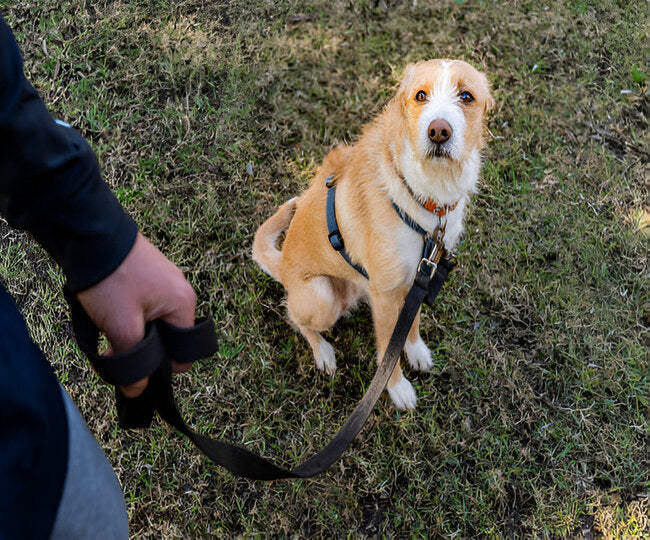Why Your Dog Won’t Walk on a Leash in 2025 – Vet‑Approved Causes & Fixes 🐾🩺

In this article
Why Your Dog Won’t Walk on a Leash in 2025 – Vet‑Approved Causes & Fixes 🐾🩺
By Dr. Duncan Houston BVSc
If your dog suddenly refuses to walk on a leash, it’s not stubbornness—it’s a signal. Dogs may halt, freeze, or resist walking due to pain, fear, fatigue, or gear discomfort. In this 2025 vet-approved guide, we’ll explore the most common medical, behavioral, and environmental reasons for leash refusal and provide actionable, compassionate solutions to help your dog walk confidently again. 🐶💬
1. 🩺 Health Issues: Pain Is a Silent Communicator
Sudden leash refusal can stem from physical discomfort. Conditions like arthritis, hip dysplasia, soft tissue injuries, or paw pad trauma are common culprits.
- Common signs: Limping, shifting weight, reluctance to move, stiffness after rest
- Check for: Thorns, cracked pads, swollen joints, limping, yelping when touched
Vet tip: Schedule a full orthopedic and neurologic exam if your dog abruptly halts on walks, especially if they were previously eager walkers. Early detection means faster, less invasive care.
2. 😨 Fear, Anxiety & Environmental Sensitivity
Fear-based leash refusal is more common than you think. Dogs overwhelmed by loud noises, traffic, new dogs, or unfamiliar surfaces may shut down completely.
- Look for: Tucked tail, lowered ears, panting, crouching, scanning surroundings
- Triggers: Fireworks, sirens, garbage trucks, other reactive dogs
What to do:
- Retrace steps or redirect to a calmer environment
- Use treats and gentle praise to build positive associations
- Desensitize slowly—stay below their fear threshold
3. 🐕 Leash Training Gaps & Gear Discomfort
If your dog’s new to leashes, a poor early experience or wrong equipment could cause resistance.
- New dog? They may need a slow indoor introduction to collar/harness and lead
- Poor gear fit: Tight collars, heavy leashes, or front-clip pressure can discourage walking
Vet recommendation:
- Start indoors—let them drag a lightweight leash during play
- Choose a padded, properly sized harness
- Reward small wins—5 steps forward gets a treat!
4. 🌡️ Fatigue, Overheating, or Breed Limits
Flat-faced breeds (Pugs, Bulldogs), seniors, or very young puppies may overheat or fatigue quickly, especially in hot weather.
- Signs: Tongue hanging out, slow pace, lying down mid-walk, refusal to move
- Solution: Walk early or late, shorten routes, bring water, use cooling vests
Breed note: Brachycephalic dogs often benefit from gentle treadmill walking or indoor enrichment in hot weather months.
5. 🧠 Behavioral Factors & Conditioning
Sometimes, leash refusal becomes learned avoidance. If the leash means stress (vet visits, being yanked), your dog may associate it with fear.
- Fix: Retrain leash association with positive reinforcement
- Games: Practice short leash drills indoors with high-value treats
- Routine: Consistent, gentle cues and expectations build confidence
6. 🧩 Step‑by‑Step Troubleshooting Plan
- Rule out physical causes with a vet exam
- Use video to observe posture, gait, leash tension
- Evaluate your leash and harness setup
- Practice short, positive walks with easy wins
- Monitor for triggers—note noise, visual, or scent aversions
📋 Quick Behavior Reference Table
| Symptom | Possible Cause | Response |
|---|---|---|
| Sudden stop, limping | Joint pain or injury | Vet check, pain meds or rehab plan |
| Tail tucked, crouch | Anxiety/fear | Redirect, desensitize, reward calm |
| Flopping, panting | Overheat or fatigue | Adjust time, gear, use indoor enrichment |
| Freezes near vet/park | Negative past event | Train new associations, add reward layers |
📱 Ask A Vet App 2025 Support
- 📹 Upload walk videos for vet/behaviorist analysis—watch gait, gear, tension
- 🧩 Receive personalized training routines and health check guidance
- 💬 Live consults to identify pain, confidence, or training strategies
❤️ Final Thoughts
When your dog refuses to walk, they’re not stubborn—they’re sending a signal. Whether it’s aching joints, overstimulation, or shaky training foundations, the key is compassionate investigation. With vet-backed steps, thoughtful training, proper gear, and supportive tech like the Ask A Vet app, you can bring joy and freedom back to the walk. 🐾
Need expert eyes on your leash challenge? Visit AskAVet.com or download the Ask A Vet app for personalized behavior plans, training help, and veterinary diagnostics—all in your pocket.






